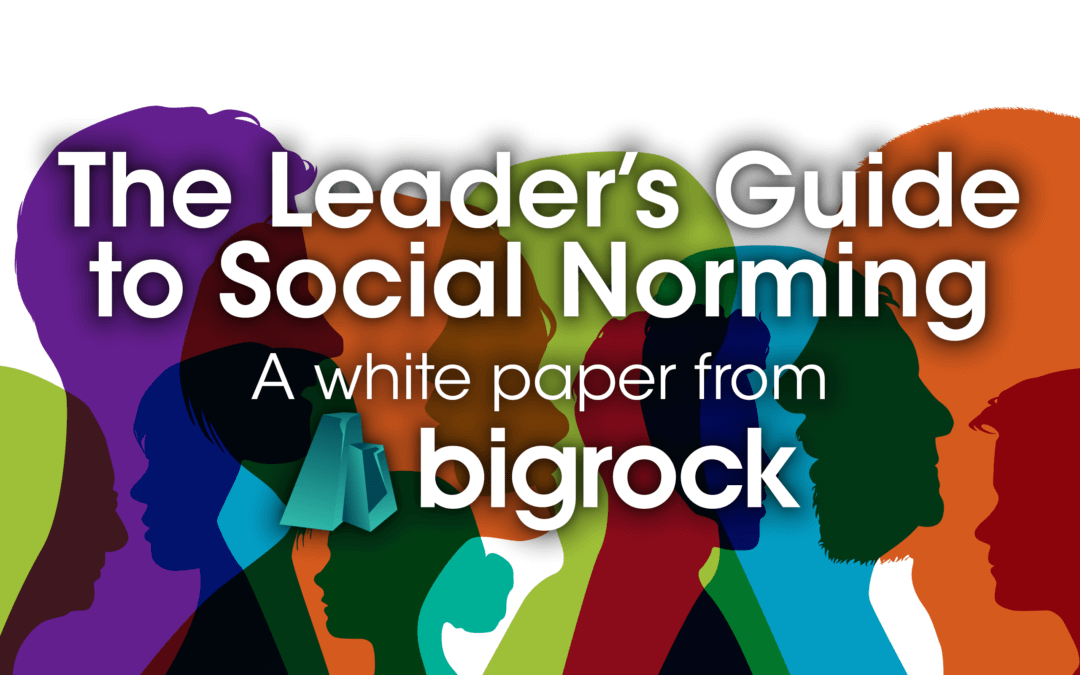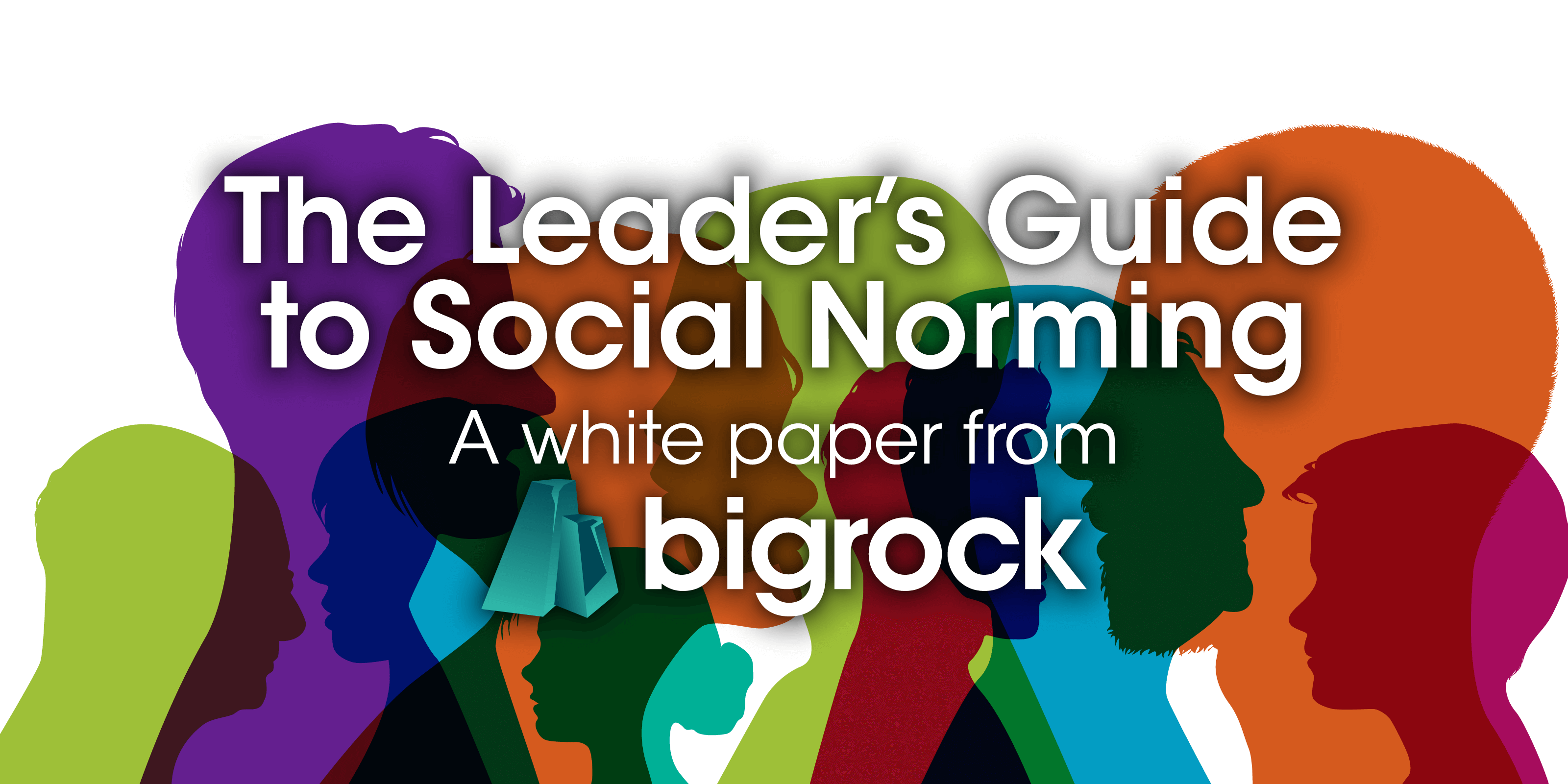Contents
1) A Leader’s Guide to Social Norming
The Business Leader’s role is to optimise the success of their organisation. One of the reasons leadership is so challenging is that the success of an organisation is largely dictated by what its people do; how they think, act and behave. So how can a Leader drive success? By implementing the right social norms.
People’s thoughts, actions and behaviours are driven by social norms. These norms will already exist within your organisation. Put simply, social norms are what your people believe is the normal way to behave. But is your current normal the right normal?
What is your team’s default position? Is it to aim to delight clients and customers? Is your organisation striving for success? Or is your team in tick over?
Leaders who can recognise their team’s existing social norms and who can introduce and promote positive social norms hold the key to optimising their organisation. In fact, we believe that implementing the right social norms should be the single biggest demand on your time and attention.
Whilst social norming is a relatively intuitive concept, scholars continue to debate how to define, test and evaluate social norming theory, its causes and effects. In this guide we put this debate to once side, to give Leaders a practical insight into how they can use social norming to optimise their leadership approach, their organisation’s culture and their team’s performance. Having studied the research, we provide an overview into what social norming is, how it can affect communications, productivity and compliance and what leaders can do to generate more positive social norms.
Don’t have time to read the whole white paper right now?
No worries. Let us send you a copy so you can read it when it’s convenient for you. Just let me know where to send it (just takes 5 seconds).
2) What is Social Norming?
Social norms are the standards by which we collectively agree appropriate behaviour. Social norms are not the rules imposed by leaders, governance or bureaucracy; instead they are our collective expectations of how our group, team or company behaves in particular situations.
The renowned Social Norms scholar Cristina Bicchieri suggests that social norms can be understood as the grammar of social interactions. When teams form they develop social norms for interacting with each other and outsiders based on their collective values. Social norms can form around dress code, how a team greets each other, the tone they use on the phone, how they approach customers, etc. While individuals can act outside of the norm, there is a social expectation for conformity.
Social norms are part of a group’s very identity; they are the subconscious go-to position, the behaviours that characterise the group. Acting outside of these feels odd, unnatural, even uncomfortable.
As such, social norms can be a highly powerful force in organisations. Teams who understand, buy-in-to and live the company’s values will build social norms that adhere to these values and prompt adhering behaviours.
If you can embed consistent social norms throughout a company, they can help promote compliance, consistency and standards of excellence.
Teams know the values they work to, what is socially acceptable in their team, and behave appropriately… even if there’s no process to follow. Put simply…
‘They know what to do even when they don’t know what to do.’
Think about the power of this. The motivation, innovation and growth that could be inspired in an organisation led not by autocratic leadership but by self driven individuals.
Where do Social Norms come from?
In most organisations, team values and the resulting social norms are set by the founders. They create their company with a clear vision, purpose and value set. However, as organisations grow and leaders’ influence on individual teams becomes more remote, it is harder to ensure every employee shares and internalises these values.
As such, teams can develop new social norms, not necessarily aligned to the firm’s values. These, in turn can prompt the wrong behaviours. A split occurs.
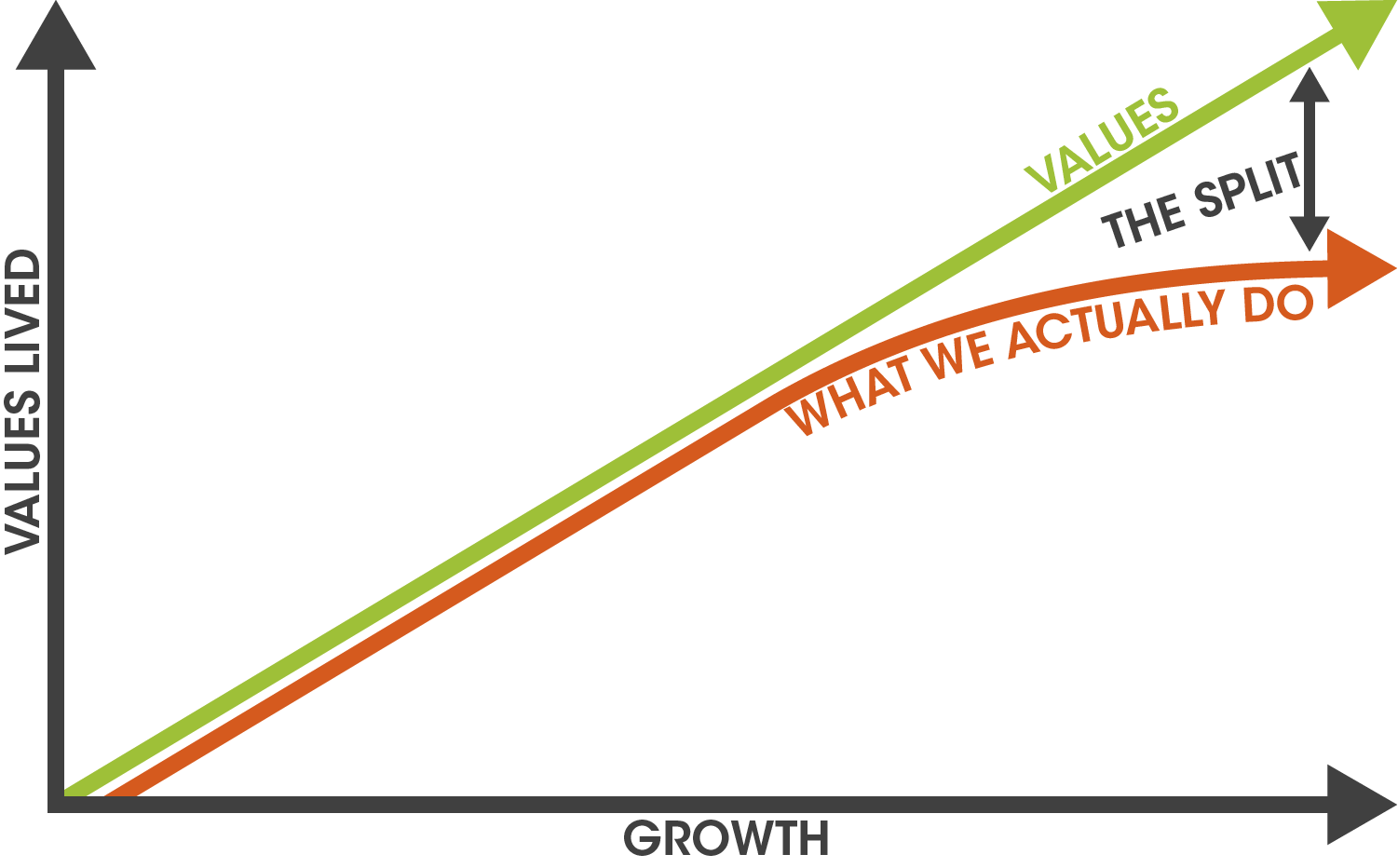
The Split: Social Norms set by the founders can falter as organisations grow and leaders become more remote.
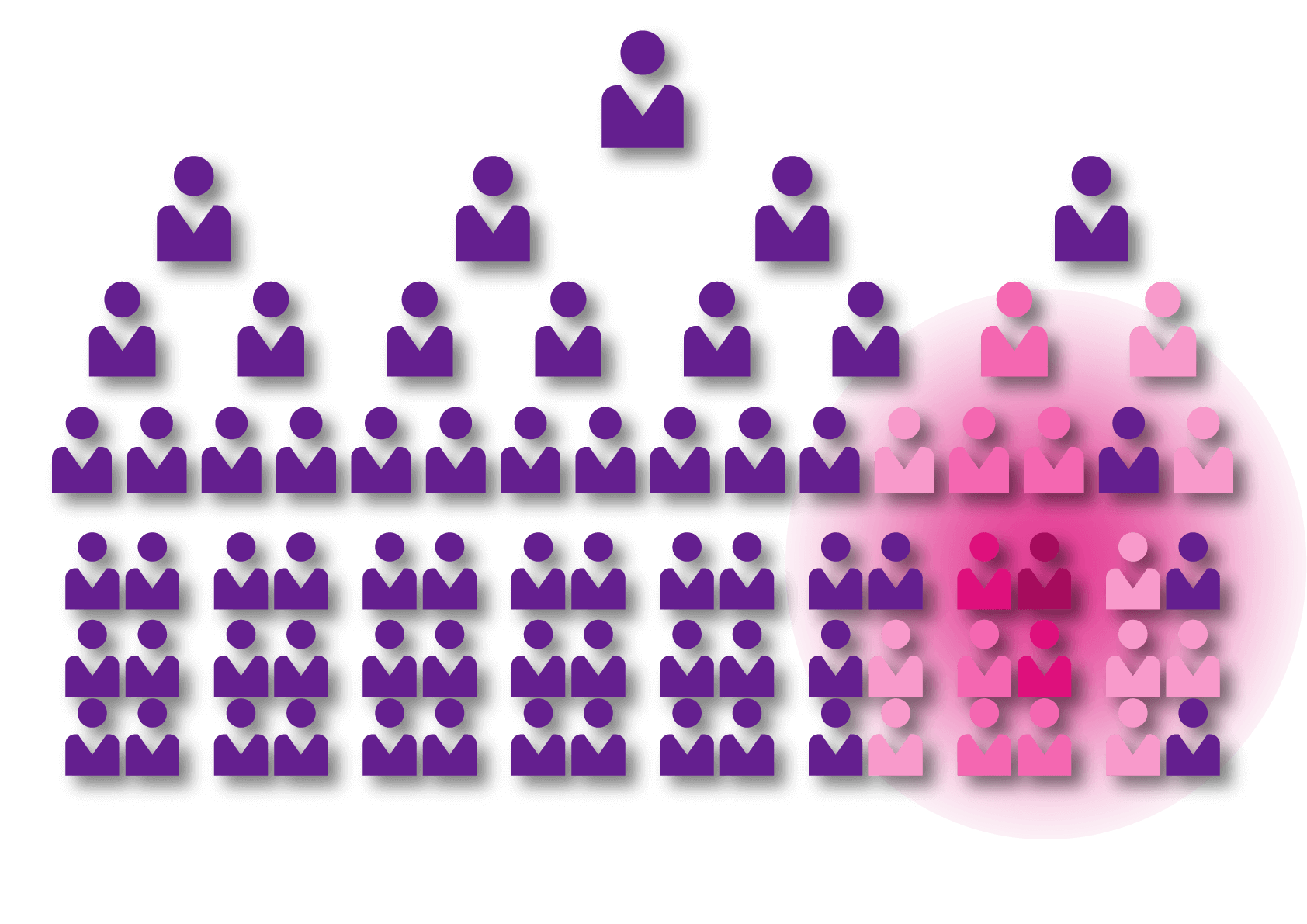
Contagion: Social Norms spread outwards from a team team to influence the whole organisation.
Both positive and negative social norms can spread beyond the small groups that form them. This can be a force for good in your organisation, with the right behaviours propagating throughout the organisation, or it can have the reverse effect. Social Norms can encourage employees to do the right things or the wrong things as they follow the trends of their peers. Norms are contagious.
After all, if everyone else around you is doing the wrong things, it’s a lot harder to buck the trend and do the right things.
Does your team have positive social norms that encourage the right behaviours?
3) The Power of Social Norms in Business
Social norms can form around anything which groups can identify with and assimilate into their expectations and behaviour. Here we outline just a few areas where leaders could harness the power of social norming to optimise culture and performance.
- Ownership and Accountability – Rather than imposing rules from above, social norming allows employees to take ownership for their behaviours both collectively and as individuals. If individuals and teams buy-in to your values, if they can identify with these values as guides to their actions, then strategic objectives can move out of the boardroom and gain real meaning for employees at the coalface. This can motivate higher levels of commitment and employee engagement, as employees recognise the effects of their actions and take ownership for the client experience they deliver.
- Compliance and Governance – This sense of ownership, taking responsibility for doing the right thing rather than just obeying rules, can be a powerful force in compliance and regulation too. Many industry regulators are increasingly recognising that those customers who need the most protection are those who are likely to have an unusual need not easily solved within process. For example, the FCA, the UK Financial Services regulator, is asking firms to concentrate on customer outcomes. Those firms that concentrate on meeting regulations are, in the regulator’s eyes, missing the point. It’s not so much about obeying the rules, as doing the right things. The right social norms help your employees know what the right things are and ensure the customer gets the best possible outcome.
- Aspiration, Effort and Performance – Social norms can be used to drive greater levels of efficiency and effort. Most teams develop a social norm around the amount of work expected of them during a day and their levels of concentration on the job in hand. It is important leaders encourage positive social norms where employees see the value and benefits of their work.Aspiration, effort & performance levels are often unwittingly set by Managers. When asked to set targets, Managers estimate an average effort level. This expectation quickly becomes the reality, the social norm, even for those who were previously aspiring to do more. Team members who before worked harder, now plateau as they notice their extra effort is ‘not needed’. Some may strive to do more but this average aspiration level will be the prevailing social norm. Conversely, those who would do less, recognise that a higher aspiration level is required and work harder.
Where does the aspiration social norm sit within your team?

Where is your firm’s social norm on the aspiration scale: One of the most common social norms is the amount of effort required of employees. Do your employees do just enough to not get fired, or do they strive for excellence?
- Social norms can be powerful motivators for those who are not putting enough effort in. Rather than being reprimanded by managers, their colleagues make them feel like they are letting the team down. However, performance social norms can also damage the moral and motivation of those who would, in a different environment, look to do more. We are so influenced by others’ expectations, that we are willing and likely to alter our behaviour in their presence—that is, to do something different than we would do if we were alone. We conform to the social norm, as to do otherwise risks embarrassment or even exclusion from group interaction.Clearly leaders should motivate team members to buy-in to an aspiration social norm that is towards the right of our scale, where everyone strives for excellence.
Research into social norms suggests the best way to motivate greater aspiration is by increasing the rewards it brings to the team as a whole. This is best achieved through group praise and good people management practices. Rewarding individuals, without recognising the team more broadly, will not impact the social norm. Roethlisberger and Dickson’s classic research showed that the prevailing social norm was more powerful than either monetary rewards or physical work environments. They found that other’s social expectations generally carry more influence than individual advantage. So, if you want to increase the aspiration social norm, you need to inspire the team as whole.
Have you experience a team of exceptionally high standards? A team where striving for excellence is everyone’s aspiration and the social norm?
What did it feel like to work in that environment?
- Client Relationships – Social norms evolve among small close-knit groups of people who have regular on-going interactions. This could be within your organisation. However, it could also be between team members and key clients. If your team’s relationships with key clients are founded on the wrong beliefs, unhealthy social norms can develop. Some client facing teams in large organisations fall into a norm of always saying yes to clients, whatever the cost. These teams have recognised the importance of delighting clients but have failed to see the broader commercial picture. They fail to see that sometimes when they say ‘yes’ they provide the client what a solution without getting any reward for the business either in terms of payment or future opportunity. Once a client is used to a norm where they always get what they ask for, however unreasonable and unprofitable to you, it can then be difficult to renegotiate a more equal relationship. Establish the right social norms for building client relationships, a social norm based on values of equal partnerships, and you can drive a great client experience and the right commercial outcomes.
4) How can leaders harness the power of social norming?
So how can leaders harness the power of social norms to enhance their organisational culture and promote behaviours that deliver the best possible customer experience and commercial outcomes?
Social norming scholars Albert & Whetten found that changing and embedding social norms is a 3 stage process:
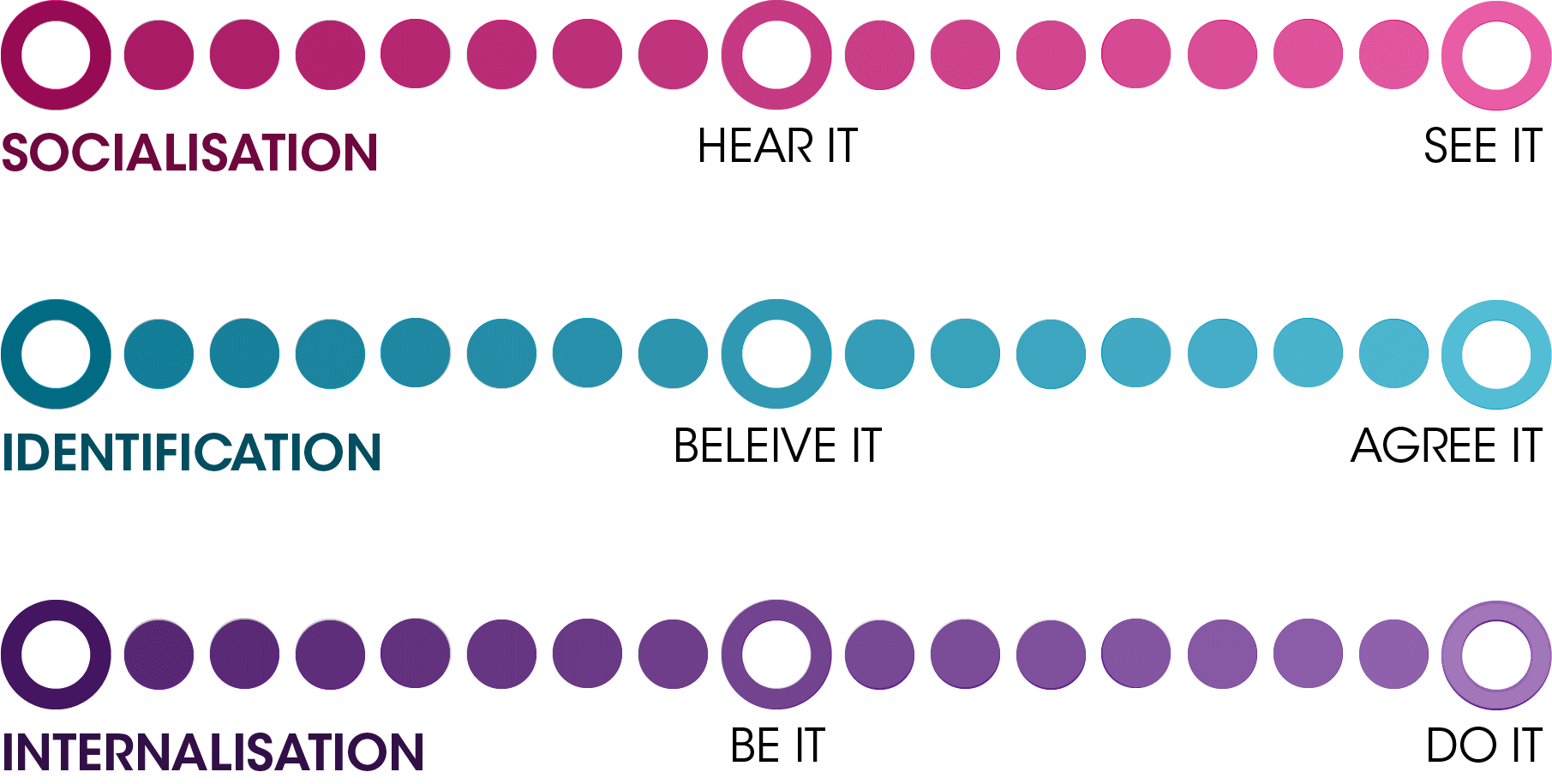
Social Norms & Corporate Culture: Leaders can create the right social norms by socialising new norms, helping employees identify with these norms and then internalise them in their daily working routine.
Stage 1 – Socialisation
For the values, beliefs and behaviours you expect of your employees to take hold, they must be highly visible within your organisation. Your employees need to see and hear your vision, your values and what you consider to be the right behaviours.
Without explicit direction, your teams can develop the wrong social norms. Teams will create norms via discussions about expected behaviours, particularly in the early stages of team development. To ensure a team’s social norms are aligned to your expectations around excellence, you must be part of these discussions.
If people do not know what excellence is, how can they achieve it?
Furthermore, if the social norm is not well communicated, pluralistic ignorance can occur. This is when individuals incorrectly perceive that other team members’ behaviours are different from their own and so adjust their behaviour to fit their perceived social norm. Pluralistic ignorance is when you believe everyone else is acting in a certain way, when actually the vast majority behave as you do. You begin adjusting your behaviours to adhere to what you believe others are doing and the actual norm begins to change.
If you introduce a social norm that is not highly visible, continually spoken of and promoted, employees may come to feel like they are the only ones adhering to this norm. They will then begin to adjust their behaviour in line with what they believe others in the company are doing.
Put simply, people know what to do but they do not believe anyone else in their team is bothering, so why should they?
Your story, your ’why’, your purpose must be continually promoted if you want your people to embrace it and act upon it. You need to reassure your team that it is important, that everyone is doing it, or trying to do it, and that it remains a core part of the firm’s vision, values and goals. Explaining, communication and socialising the right behaviours is the first step to embedding them as social norms.
Yet, hearing and seeing the social norm is not enough. This brings us on to the next stage of Identification
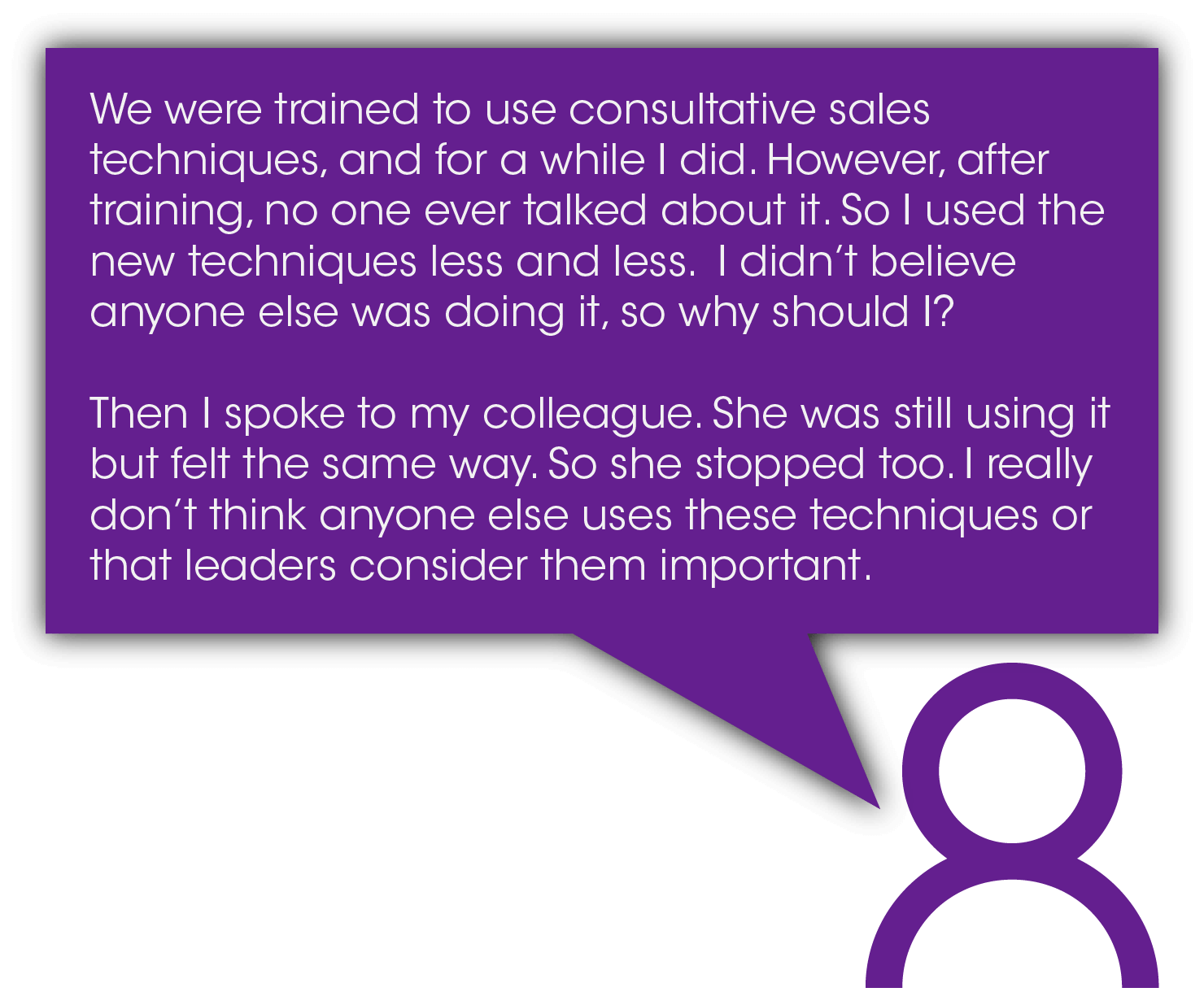
Pluralistic Influence undermining the desired Social Norm: If desired values and behaviours are not visible, people may think the only ones using them, and stop doing so.
Stage 2 – Identification
Team members need to agree with and believe in the principle for it to become an effective social norm. A social norm is powerful when everyone in a team buys into the norm, understands how the norm drives great results and are passionate about maintaining the norm.
Your colleagues need to understand how a new rule, process or required behaviour is relevant to them and their work. How will it drive improved results? How will it improve the customer experience or consumer outcomes? How will it bring the business commercial advantage? How will it help the team succeed and reach their targets?
A strong understanding of the results they can expect from implementing a social norm will help your team agree and believe in its principles. This belief will help them implement the behaviours and actually gain the results.
When they see the results come to fruition (and you emphasise them through further socialisation, making sure success is seen, heard and attributed to the new behaviour, the new social norm) their belief in the norm will be strengthened.
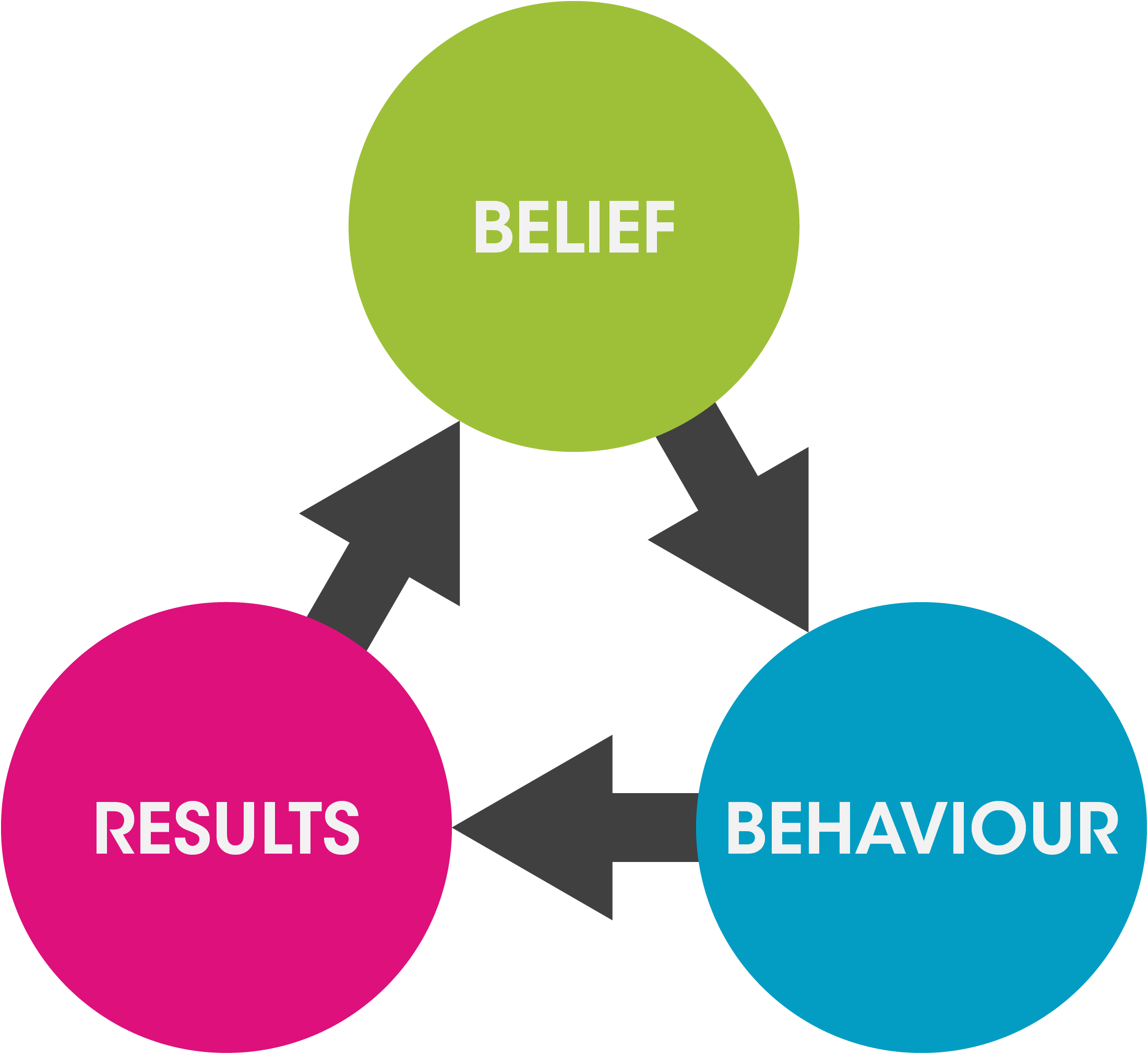
Beliefs drive Behaviours which drive Results: Strong results strengthen our beliefs and ensure the spiral of success continues.
Overcoming the Fear of Vulnerability
Change can make people feel vulnerable. Doing something in a different way to what you’ve grown used to can be extremely difficult and feel strange. You are essentially fighting the existing social norm in order to build a new one and, as we’ve seen, social norms can be very powerful. You are asking people to step outside the existing social norm, to risk the rejection of their peers or, when pluralistic ignorance is in play, the perceived risk that everyone else may reject them. How do you overcome this fear of vulnerability? By recognising the fear, helping the team recognise that the old social norm is holding them back and challenging them to accept, buy into and try new ideas and behaviours, first in a development setting and then for real.
It is all about building trust. Trust in you the leader and trust in each other that new ideas will be welcomed and that people will be allowed to make mistakes and then learn from them. Trust that everyone is ready to adopt the new social norm. Patrick Lencioni identified Absence of Trust as one his five dysfunctions of a team. All five dysfunctions can prove highly damaging to your team’s effectiveness if they pervade your team’s culture and become part of the social norm. In fact, we would encourage leaders to begin by making sure the reverse of Lencioni’s model exist as social norms in their teams, (i.e. trust, true harmony, commitment, taking responsibility and attention to results).
Patrick Lencioni’s Five Dysfunctions of a Team: Lencioni identified Absence of trust, or the Fear of Vulnerability, at the bedrock of dysfunctional teams.
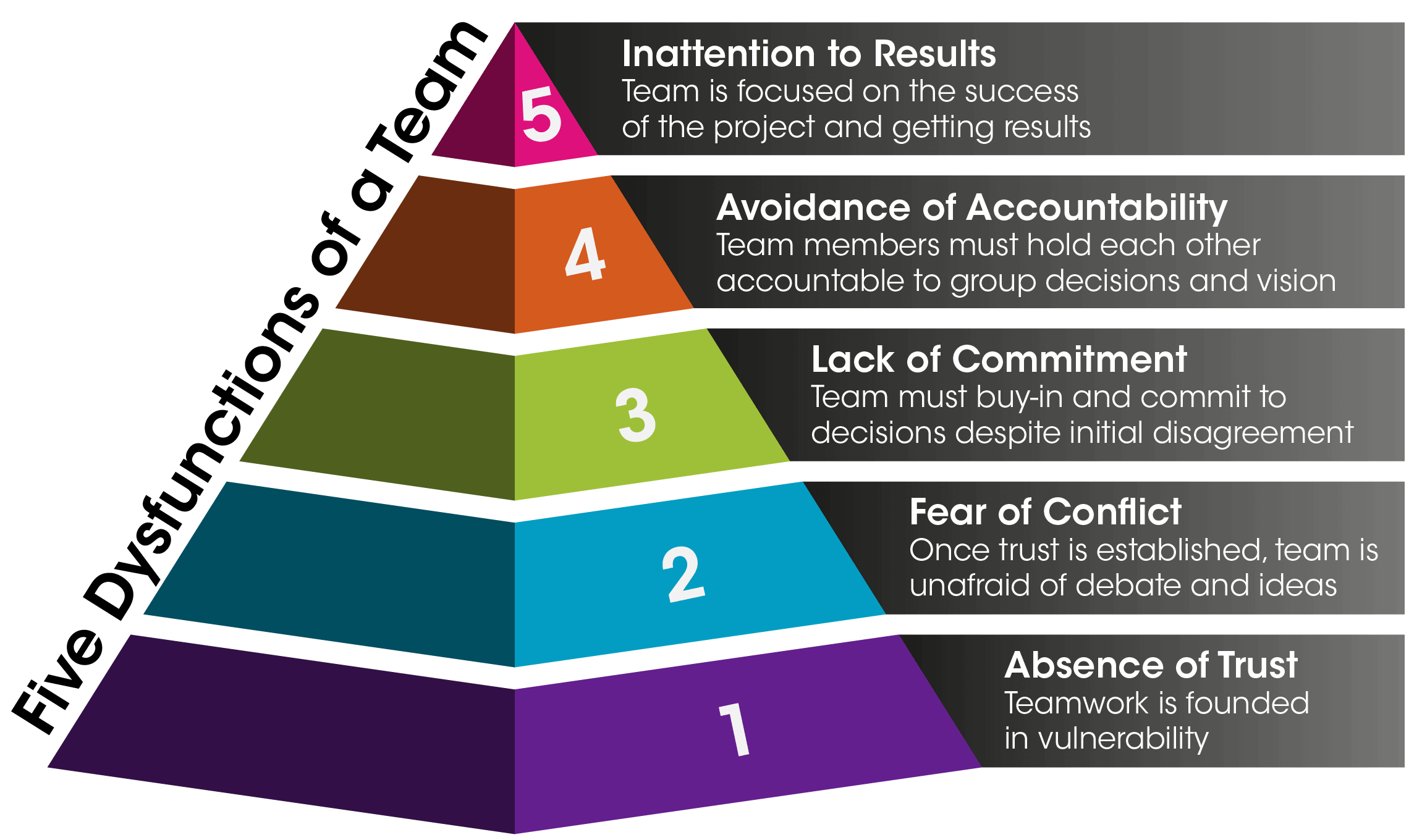
Stage 3 – Internalisation
For stage 3, you simply have to do it. Abide by the social norm every day, all of the time. As a leader, your team will look to you to set the right behaviours and the right social norm. If you don’t practice what you preach, they will think you don’t mean what you say, that the new behaviours are not important.
This may seem a big ask. Your team has time to get used to the social norm and implement it gradually. As a leader, you don’t. You will be immediately judged on how you act, and whether these actions live up to the norms you have socialised and encouraged others to identify with. Make sure you lead from the front and abide by the rules. For a social norm to take hold, it has to apply to everyone, especially the leaders.
The true test of a social norm comes in the hard times. In the good times people know what to do and do it. In the hard times it may not be that simple. Even though people know the expected social norm, they may find ways to work around it. When under pressure they may relapse into unacceptable behaviours. Team members are aware that these unacceptable behaviours let down the team, so they revert to these behaviours in secret. This is why social norming cannot replace governance. It is also why leaders must continually reinforce the importance of a social norm. You should be the role model for new behaviours, their greatest advocate and biggest success, even when you feel you don’t have the time or energy.
Help your people do it and be it by doing and being it yourself!
Not only are you the visionary and storyteller for the social norm. You are the change agent and servant that makes sure it happens.
5) Social Norming and the Leader’s role
Leaders have traditionally been seen as strategists, commanders and system architects. They were the rule setters, the law makers. However, leadership gurus are increasingly advocating a new style of leadership, whereby the leader is characterised as a visionary, a storyteller, a change agent and a servant to his or her employees.
Rather than strategizing, be a Visionary. Identify where you are going as an organisation, why and how. Take your values and purpose to the organisation.
Rather than commanding, be a Storyteller. Explain your purpose and inspire your team to action.
Finally be an Agent for Change and a Servant to your employees. Clear the path, remove the blockers, be an enabler to help your people achieve.
This model for leadership is illustrated in this infographic:
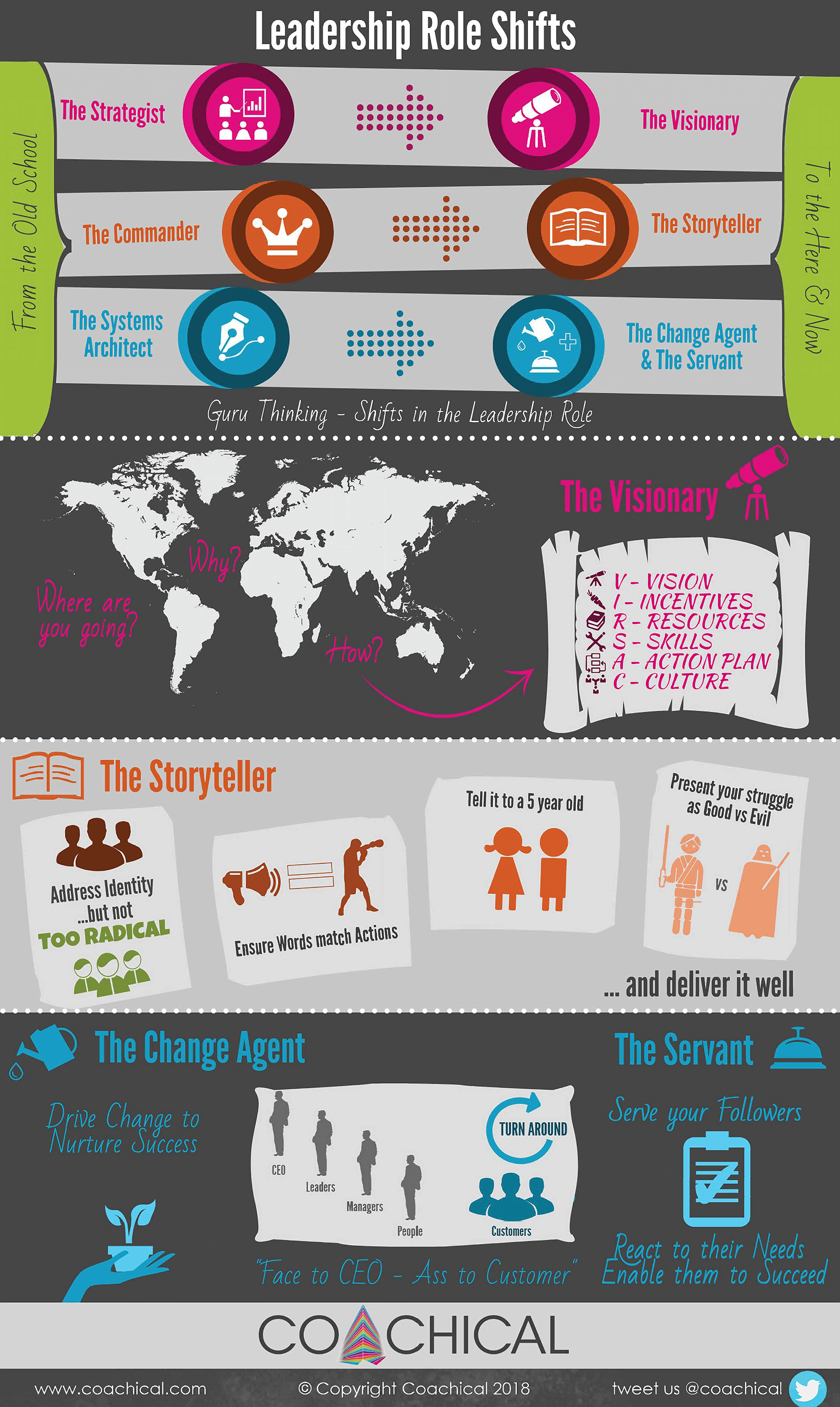
Leadership Role Shifts: The new leadership roles of visionary, storyteller, change agent and servant are perfect for establishing the right social norms.
Social norming fits perfectly with this new approach to leadership. Norms are not rules and strategy that require or prohibit behaviour from above. Instead, team members themselves agree and reinforce norms through their behaviour. Yet, the clearer and more explicit the norms are, the more effective they are at encouraging the right behaviours.
As such, Leadership is about making sure the right social norms are the ones most clearly and frequently seen and heard by team members.
Rather than enforcing rules, it is the leader’s role to promote their vision, their values and intentions across the business.
It is their role to tell their story, to create and embed the right social norms.
Leaders should act as change agent and a servant for social norms, providing the vision, drive and momentum to inspire employees to succeed.
Leadership guru’s Jennifer Chatman & Sandra Eunyoung Cha explained the irony of the leaders’ role as follows;
“The irony of leadership through culture is that the less formal direction you give employees about how to execute strategy, the more ownership they take over their actions and the better they perform. … Employees have to be freed up from rules in order to deliver fully on strategic objectives; they have to understand the ultimate strategic goals and the norms through which they can be successfully achieved, and they must care about reaching those goals and what their co-workers will think of them if they don’t. Strong norms increase members’ clarity about priorities and expectations as well as their bonds with one another. Unlike formal rules, policies, and procedures, culture empowers employees to think and act on their own in pursuit of strategic objectives, increasing their commitment to those goals. Violations are considered in terms of letting their colleagues down rather than breaking rules.”
After all, formal rules don’t result in excellence. An outstanding customer experience does not come from process. When customers or clients are wowed, it’s usually because someone went above and beyond the call of duty to solve their problem. Whilst formal rules standardise performance, effective social norms give employees the freedom and confidence to go that extra mile for the customer, whilst remaining true to your organisation’s values.
Strategy and governance are important and social norm theory does not suggest they should be scrapped. Instead, social norms can help create a culture that strengthens these elements; a culture that ensures the driving principles behind the rules are understood and applied right down the line. It’s about creating social norms that will actually lead to the delivery of your strategy and drive the best possible customer outcomes.
Bigrock can help leaders understand their role in developing, implementing and maintaining the right social norms. Through leadership and organisational change programmes we can help you and your organisation get the right results by harnessing the power of social norms.
To learn more about social norming and how Bigrock can help you bring your vision to life through the power of social norms please email enquries@bigrockhq.com or call +44 (0)1280 820 780 to arrange a consultation call.
Subscribe below to receive our latest insights direct to your mailbox.
Bibliography
Albert, S., & Whetten, D. A. (1985) Organizational identity. In L. L. Cummings & B. M. Staw (Eds.), Research in organizational behavior (Vol. 7, pp. 263-295). Greenwich, CT: JAI Press
Bicchieri, Cristina and Muldoon, Ryan “Social Norms”, The Stanford Encyclopedia of Philosophy (Spring 2014 Edition), Edward N. Zalta (ed.), http://plato.stanford.edu/archives/spr2014/entries/social-norms/> (accessed 18/2/2015).
Boundless. “The Role of Social Norms in Teams.” Boundless Management. Boundless, 08 Dec. 2014. from https://www.boundless.com/management/textbooks/boundless-management-textbook/groups-teams-and-teamwork-6/factors-influencing-team-performance-54/the-role-of-social-norms-in-teams-271-3946/ (Accessed 18/2/2015).
Chatman, Jennifer A. & Eunyoung Cha, Sandra ‘Leading by Leveraging Culture’, California Management Review, Vol 45. No. 4, (Summer 2003), (pp. 20-34).
Stamper, Ronald; Liu, Kecheng; Hafkamp, Mark And Ades, Yasser ‘Understanding the Roles of Signs and Norms in Organisations – A semiotic approach to information systems design’, Journal of Behaviour & Information Technology (2000), vol. 19 (1), pp 15-27.
